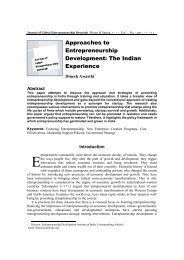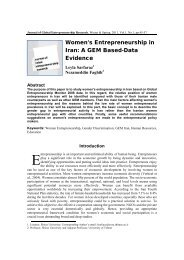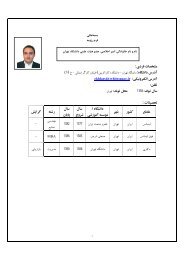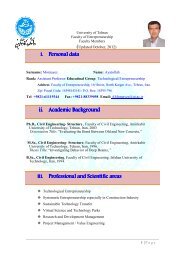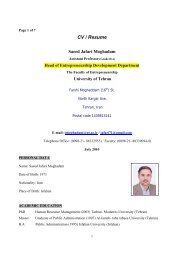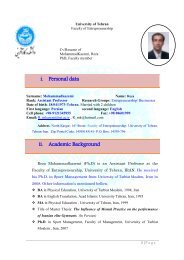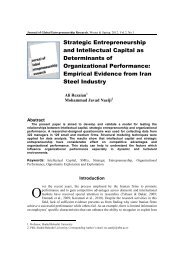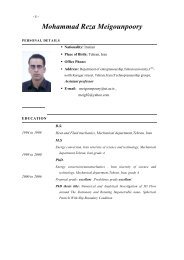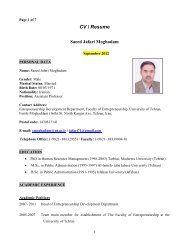Knowledge Creation Processes
Knowledge Creation Processes
Knowledge Creation Processes
You also want an ePaper? Increase the reach of your titles
YUMPU automatically turns print PDFs into web optimized ePapers that Google loves.
Journal of Global Entrepreneurship Research, Winter & Spring, ٢٠١١, Vol.١, No.١, pp.٥٩-٧١<br />
<strong>Knowledge</strong> <strong>Creation</strong><br />
<strong>Processes</strong>:<br />
A Survey of SMEs<br />
In the Iranian Province of<br />
Mazandaran<br />
Hassanali Aghajani ١<br />
Mahmood Yahyazadehfar ٢<br />
Seyed Aliakbar Hosseinzadeh ٣<br />
Abstract<br />
The study is based on Nonaka and Takeuchi’s (١٩٩٥) knowkedge creation processes<br />
(KCP) model and a standardized questionnaire. According to this approach, the survey<br />
was conducted on ٣٠٠ active SMEs of Mazandaran Province. Based on the structural<br />
equation modeling, socialization (٠٫٩٦) has more effect on KCP. Moreover, the variables<br />
of externalization (٠٫٧٩), combination (٠٫٥٤) and internalisation (٠٫٥٣) stand in next<br />
levels respectively. The managers of SMEs in Iran can utilize this structural equation to<br />
measure their firms’ potentials in organisational performance improvement and find the<br />
situation of their firms compared to peer groups.<br />
Keywords: <strong>Knowledge</strong> <strong>Creation</strong> Process, SMEs, Socialization, Externalization,<br />
Combination, Internalization<br />
I<br />
Introduction<br />
n many organizations, knowledge management (KM) is critical to decisionma-king that<br />
directly impacts the organizational effectiveness and competitiveness. Conversion of<br />
tacit knowledge to explicit knowledge or at least ability to share it offers greater value<br />
to an organization. The exact point of tacit knowledge transmission is unconscious tacit<br />
knowledge that becomes conscious tacit knowledge that is the point at which awareness hits<br />
us. This is the tacit meta-knowledge point. For individual thinkers, this is a critical moment of<br />
awareness. But, explicit knowledge can be stored in databases and manuals (Mohamed et al.,<br />
٢٠٠٦; Hosseinzadeh, ٢٠٠٩).<br />
Nonaka and Takeuchi (١٩٩٥) suggested that tacit knowledge becomes explicit through the<br />
process of externalization, i.e. by sharing metaphors and analogies during social interaction. In<br />
fact, there is not a clear distinction between explicit knowledge, which is defined as knowledge<br />
that is codifiable, able to be articulated, and thus can be communicated, and tacit knowledge,<br />
١. Assistant Professor, University of Mazandaran; Corresponding Author's email: aghajani@umz.ac.ir<br />
٢. Assistant Professor, University of Mazandaran<br />
٣. MA Graduate, University of Mazandaran
which can not be codified and articulated and is ‘personal’. He made the simple observation<br />
that in the case of tacit knowledge ‘we know more than we can tell’ (Gopalakrishnan et al.,<br />
٢٠٠١). Tacit knowledge is defined as experience-based knowledge that resides within an<br />
individual, whereas explicit knowledge is precise, formally articulated and documented. In<br />
organizations, knowledge is often embedded in repositories, documents, routines, operational<br />
processes, practices, and norms. It is generally accepted that knowledge also comes from the<br />
meaningfully organized accumulation of information through experience, communication, or<br />
inference (Zack, ١٩٩٩).<br />
The duty of KM is not about managing knowledge but about changing the entire business<br />
cultures and strategies of organizations to ones that are value learning and sharing (Kakabadse<br />
et al., ٢٠٠٣). By implementing the appropriate KM, the firm changes the knowledge assets,<br />
which depends on the quality of organizational knowledge and intangible assets in general, to<br />
obtain opportunity for sustainable competitive advantage (Lee et al., ٢٠٠٥). That is, the<br />
knowledge–based view of the firm suggests that intellectual resources are key organizational<br />
assets that will spur sustainable competitive advantage (Alavi et al., ٢٠٠٦). But, what is the<br />
operational method of promoting knowledge assets? What is the effect of knowledge creation<br />
process factors? and, what is the structural equation model of KCP in a firm?<br />
Some studies have suggested that knowledge creation is the most critical to an<br />
organization’s long-term success (Fahey & Prusak, ١٩٩٨). <strong>Knowledge</strong> creation process<br />
should drive the capability of creating and adding a greater value to the core business<br />
competencies (Lin & Tseng, ٢٠٠٥). According to Lee and Choi’s (٢٠٠٣) study, companies<br />
should attempt to link knowledge processes with intermediate outcomes. They revealed some<br />
of the outcomes of KCP’s factors that fall under the categories of organizational creativity,<br />
innovation and performance improvement.<br />
First, the KCP’s factors affecting the amount of knowledge creation process are explained<br />
via the literature review and an empirical examination of SMEs in the Mazandaran Province.<br />
Then, the structural equation model of KCP in the SMEs of the Mazandaran Province is<br />
presented. The SECI model of this research is shown in Figure١.<br />
Effective Factors (Independent Variables) of KCP<br />
Socialization<br />
Externalization<br />
Combination<br />
Internalization<br />
<strong>Knowledge</strong> <strong>Creation</strong><br />
Process (KCP)<br />
Fig. ١. The SECI Research Model<br />
<strong>Knowledge</strong> <strong>Creation</strong> <strong>Processes</strong>: A Survey of SMEs in The Iranian Province of Mazandaran ٦٠
Literature Review<br />
Tacit knowledge is the knowledge that cannot be easily described such as skills,<br />
experience or inherent talent, but explicit knowledge is the skills and facts that can<br />
be written down and taught to others such as technical documents (Polanyi, ١٩٦٧;<br />
Hosseinzadeh, ٢٠٠٩). Brooking (١٩٩٦) defines that organizational knowledge is<br />
the collective sum of market assets, infrastructure, intellectual property and human-centered<br />
assets. Management is defined as the strategy-driven motivation and facilitation of people,<br />
aimed at reaching an organization’s set goals (Roelof & Beijerse, ١٩٩٩). <strong>Knowledge</strong><br />
management (KM) refers to the process of capturing the collective expertise and intelligence in<br />
an organization and using them to foster innovation through continued organizational learning<br />
(Nonaka, ١٩٩١; Quinn et al., ١٩٩٦; Davenport & Prusak, ١٩٩٨). KM is complex because<br />
knowledge is intangible and surfaces in a variety of forms (Rowley, ٢٠٠٤; Golipour et al.,<br />
٢٠١٠). O’Dell and Grayson (١٩٩٨) believe that knowledge management is assumed to be all<br />
systematic approaches to finding, understanding, and using knowledge to create value. Recent<br />
contributions to the study of knowledge management have moved from a focus on information<br />
indexing and retrieval systems to effective knowledge management through human resource<br />
practices (Nonaka & Toyama, ٢٠٠٣; Soliman & Spooner, ٢٠٠٠; Bhatt, ٢٠٠١). The two<br />
objectives of knowledge management are to make the organization ‘act as intelligently as<br />
possible in order to secure its viability and overall success; and otherwise realize the best value<br />
of its knowledge assets’ (Wiig, ١٩٩٣, ٧١-٧٢).<br />
There is an overemphasis on information technology and other measurement tools in many<br />
organizations that can undermine knowledge management and creation in a constricting<br />
paradigm rather than an enabling one (Krogh et al., ٢٠٠٠). Zarraga and Garcia-Falcon<br />
(٢٠٠٣) believe that the knowledge is buried in the minds of individuals. The knowledge that<br />
has been created by each of the individuals within the organization will have to be transferred<br />
from those individuals to others in order to be shared. Those separate pieces of knowledge,<br />
once transferred and received, will have to be integrated and become one mass of knowledge.<br />
The knowledge transferred to each individual will be integrated with the knowledge that they<br />
already possess and be internalized to the point that it becomes one set of knowledge.<br />
Therefore, knowledge management can be conceptualized as a process whose input is the<br />
individual knowledge of a person, which is created, transferred and integrated in work teams<br />
within the company, while its output is organizational knowledge (Zarraga & Garcia-Falcon,<br />
٢٠٠٣; Dutta et al., ٢٠٠٥). Therefore, the most challenging practical problem for the<br />
understanding of KM is to give priority to human factors (Svetlik & Stavrou-Costea, ٢٠٠٧;<br />
Golipour, ٢٠١٠).<br />
What are the main processes that create organizational knowledge? How should knowledge<br />
creation be measured in organizations? A useful way of coming to understand the processes of<br />
KCP is to study various models of knowledge creation process. Models of processes give<br />
visual ways of thinking about visual metaphor. Therefore, all of these statements show the<br />
output of knowledge creation process which, as KCP in this research, is hidden, intangible or<br />
invisible (Hosseinzadeh, ٢٠٠٩).<br />
Selection of The KCP Model<br />
Many studies have addressed knowledge management processes and have divided<br />
knowledge management into several processes. Alavi and Leidner (٢٠٠١) considered the four<br />
processes which include creation, storage, transfer and application. These processes are often<br />
concurrent and not always in a linear sequence. Lee et al. (٢٠٠٥) describe components of<br />
knowledge management processes into knowledge creation, accumulation, sharing knowledge<br />
and knowledge internalization. In this way, organizations need to support the combination of<br />
٦١<br />
Journal of Global Entrepreneurship Research, Winter & Spring ٢٠١١, Vol.١, No.١, pp. ٥٩-٧١
various components of the knowledge management system, such as developing its<br />
infrastructure, securing new and existing knowledge, distributing it, and combining it.<br />
Allard and Holsapple (٢٠٠٢) suggest a knowledge chain model to gain competitive<br />
advantage in e-commerce. Beckett et al. (٢٠٠٠) develop a framework with three KM<br />
strategies– acquisition, retention, and exploitation. Chakravarthy et al. (٢٠٠٣) identify three<br />
KM activities –knowledge protection, knowledge leverage and knowledge accumulation.<br />
Chuang (٢٠٠٤) investigates the KM capability from four KM resources – technical, human,<br />
cultural, and structural. Gloet and Terziovski (٢٠٠٤) claim that KM implements human<br />
resource management practices and IT practices lead to higher innovation within an<br />
organization. Sabeherwal and Becerra-Fernandex (٢٠٠٣), using Nonaka and Takeuchi’s SECI<br />
model, argue that socialization and combination influence organizational effectiveness. The<br />
study also shows that individual effectiveness affects group effectiveness, which, in turn<br />
affects organizational effectiveness (Sabeherwal & Becerra-Fernandex, ٢٠٠٣). Chan and<br />
McKeen (٢٠٠٦) identified four elements for knowledge processes: A) scanning process: an<br />
emphasis on scale and scope of the scanning process that assists organizations to recognize<br />
novel knowledge that subsequently enhance the organization’s innovations, B) knowledge<br />
experimentation process: Brown and Eisenhardt (١٩٩٧) argue that experimenting “into the<br />
future” can include four tactics. First, organizations must be able to quickly experiment the<br />
knowledge to see if it is useful. Second, the organizations should have a group of futurists,<br />
whose primary task is to think in the future. Third, organizations must be in a position to form<br />
partnerships with others to probe and anticipate the future, and finally, they should hold<br />
frequent meetings to ponder over the future, C) knowledge transfer process: Organizations<br />
should encourage formal and informal networks for knowledge transfer, D) knowledge<br />
integration process: the final stage in gainfully using the knowledge that has been determined<br />
to be useful and transferred is its integration with knowledge existing in parts of the<br />
organization for innovation (Cohen & Levinthal, ١٩٩٠; Kogut & Zander, ١٩٩٢; Leonard-<br />
Barton, ١٩٩٥).<br />
Despite several descriptions provided for the KM process, it is commonly accepted that<br />
KM refers to acquiring, storing, diffusing and applying knowledge (Shin et al., ٢٠٠١; Benbya<br />
et al., ٢٠٠٤; Chen & Chen, ٢٠٠٥). <strong>Knowledge</strong> creation is a critical competitive weapon in<br />
today’s global marketplace and without a continuous knowledge creation, a business is<br />
doomed to failure (Choi & Lee, ٢٠٠٣). We follow this concept which is consistent with<br />
studies that focus on knowledge creation (Choi & Lee, ٢٠٠٣; Sabherwal & Becerra-<br />
Fernandex, ٢٠٠٣; Chou, ٢٠٠٥). Nonaka and Takeuchi (١٩٩٥) introduced the SECI Model<br />
(acronym for Socialization, Externalization, Combination and Internalization) as a model of<br />
knowledge creation based on the action and interaction between tacit and explicit knowledge.<br />
Even though Nonaka suggest that a failure to build a dialogue between tacit and explicit<br />
knowledge can cause problems (Nonaka et al., ١٩٩٤), many researchers have focused on<br />
separating these knowledge dimensions and measured the individual impact that explicitoriented<br />
(or tacit-oriented) KM initiatives have on corporate performance (Bohn, ١٩٩٤;<br />
Hansen et al. ١٩٩٩; Singh & Zollo, ١٩٩٨; Swan et al., ٢٠٠٠).<br />
Our study adopts the SECI for the following reasons. First, this model has become widely<br />
accepted (Scharmer, ٢٠٠٠); it has been used in many research areas such as organizational<br />
learning, new product development, and IT (Scharmer, ٢٠٠٠; Scott, ١٩٩٨). Second, this<br />
model includes not only knowledge creation but also knowledge transfer. The transfer of<br />
existing knowledge and the creation of new knowledge are important, and both of them should<br />
be considered in knowledge management (Krogh et al., ٢٠٠١).<br />
<strong>Knowledge</strong> <strong>Creation</strong> <strong>Processes</strong>: A Survey of SMEs in The Iranian Province of Mazandaran ٦٢
SECI Model and Hypotheses of Research<br />
Nonaka and Takeuchi (١٩٩٥) proposed that knowledge conversion, from tacit to explicit<br />
knowledge and vice-versa, occurs through a life ‘knowledge flow’ cycle: socialization,<br />
externalization, combination and internalization. Therefore, knowledge management can be<br />
described as management of the environment, making knowledge flow through different<br />
phases of its life cycle.<br />
Socialization<br />
Socialization is the process of converting tacit knowledge into explicit through shared<br />
experiences. Since tacit knowledge can not be expressed by spoken language, the conversion<br />
has to take place through experiences, such as observation, imitation, and practice. According<br />
to Nonaka et al. (٢٠٠٠), socialization typically occurs in a traditional apprenticeship, where<br />
apprentices learn the tacit knowledge needed in their craft through hands-on experience.<br />
Socialization also may occur in informal social meetings outside the workplace, where tacit<br />
knowledge such as world-views, mental models and mutual trust can be created and shared.<br />
Finally, socialization can occur beyond organizational boundaries. Organizations often acquire<br />
and take advantage of the tacit knowledge embedded in customers or suppliers by interacting<br />
with them.<br />
H١: <strong>Knowledge</strong> creation process is explanatory of socialization as one of the observed<br />
independent variables.<br />
Externalization<br />
Externalization is the interchange of tacit knowledge to explicit knowledge. Externalization<br />
is defined as the process of articulating tacit knowledge into explicit knowledge. When tacit<br />
knowledge is made of explicit, knowledge is crystallized, which allows it to be shared by<br />
others, and it becomes the basis of new knowledge (Nonaka et al., ٢٠٠٠). The concept of new<br />
product development and a quality control circle are examples of this conversion process. The<br />
tools of this conversion use different metaphors, analogues, concepts, hypotheses and models.<br />
If workers can find knowledge from the knowledge source of organization or firm, they are<br />
able to apply it to complete their work successfully (Lee et al., ٢٠٠٥).<br />
H٢: <strong>Knowledge</strong> creation process is explanatory of externalization as one of the observed<br />
independent variables.<br />
Combination<br />
Combination is the interchange of tacit knowledge with tacit knowledge. Nonaka et al.<br />
(٢٠٠٠) defined the combination as the process of converting tacit knowledge into more<br />
complex and systematic sets of explicit knowledge. Explicit knowledge can be collected from<br />
inside or outside the firm and then combined, edited or processed to form new knowledge.<br />
This new explicit knowledge can be directly disseminated among the members of the<br />
organization by presentations or meetings (Nonaka & Konno, ١٩٩٨). Organizations need to<br />
support the combination of various components of your system, such as developing its<br />
infrastructure, securing new and existing knowledge, distributing it, and combining it (Lee et<br />
al., ٢٠٠٥).The combination mode of knowledge conversion can also include the ‘breakdown’<br />
of concepts. Breaking down a concept such as a corporate vision into operational business or<br />
product concepts will also create systemic and explicit knowledge (Nonaka et al., ٢٠٠٠).<br />
H٣: <strong>Knowledge</strong> creation process is explanatory of combination as one of the observed<br />
independent variables.<br />
٦٣<br />
Journal of Global Entrepreneurship Research, Winter & Spring ٢٠١١, Vol.١, No.١, pp. ٥٩-٧١
Internalization<br />
Internalization is the process of embodying explicit knowledge into tacit knowledge<br />
(Nonaka et al., ٢٠٠٠). The explicit knowledge may be embodied in actions and practice, so<br />
that the individual acquiring the knowledge can re-experience what others go through.<br />
Sabherwal et al. (٢٠٠٣) state that individuals could acquire tacit knowledge alternatively, in<br />
virtual situations, either vicariously by reading or listening to others' stories, or experientially<br />
through simulations or experiments. Learning by doing, learning by observing, face-to-face<br />
meetings, and on-the-job training are some of the means individuals acquire knowledge<br />
through the internalization processes (Sabherwal et al., ٢٠٠٣). Therefore, internalization may<br />
give rise to new knowledge (Lee et al., ٢٠٠٥).<br />
H٤: <strong>Knowledge</strong> creation process (KCP) is explanatory of internalization as one of the<br />
observed independent variables.<br />
Based on the above discussions, the main hypothesis is as follows:<br />
H٥: The generality of the proposed model and their related variables<br />
(Socialization, Externalization, Combination and Internalization) are<br />
confirmed and have significant fitness in the SMEs of the Mazandaran<br />
Province.<br />
Methodology<br />
This study is conducted as a standard questionnaire-based survey of middle managers<br />
at the Iranian small and medium sized enterprises to present the structural equation<br />
model of knowledge creation process in an empirical examination. Samples are<br />
selected from active SMEs of Mazandaran Province. The sample is randomly<br />
selected with the same probability. The manager of each selected firms is asked to respond to<br />
the questionnaire. Questionnaires were distributed among ٥٠٠ middle managers of sample<br />
firms out of ١،٥٠٠ SMEs. ٣٠٠ usable responses were received, providing a response rate of<br />
٦٠٪.<br />
The alpha level selected was ٠٫٠٥ (Lee & Choi, ٢٠٠٣; Saarenket et al., ٢٠٠٣).<br />
A multiple-item method was used to construct the questionnaire. Each item was based on a<br />
ten point scale, from "very low" to "very high". Questionnaire items for the explanation of the<br />
knowledge creation process, which were used in this study, had been validated. Because in this<br />
research the items of Nonaka and Takeuchi’s model are taken from Lee and Choi’s (٢٠٠٣)<br />
study to be localized, then two professors and two doctoral candidates who had been studying<br />
KM for years confirmed the validity of the questionnaire.<br />
Research constructs were operationally on the basis of related studies (Lee & Choi, ٢٠٠٣).<br />
One test in this study was for measuring reliability. There are various methods to determine the<br />
reliability of the tools of measurement one of which is the assessment of internal conformity<br />
(Conca et al., ٢٠٠٤). The internal conformity of measurement tools can be measured by the<br />
coefficient of Cronbach Alpha (Cronbach, ١٩٥١) and it was equal to ٠٫٨٩٨ by using SPSS ١<br />
software for all of the items.<br />
Other tests in this study were ANOVA ٢ , binomial test (for specifying effective\ ineffective<br />
factors), T-value test, estimate model, standard solution, structural equation modeling (SEM),<br />
and focuses on important indexes of LISREL ٣ software similar to Root Mean Square Error of<br />
١. Statistical Package for the Social Science<br />
٢. Analysis of Variance<br />
٣. Linear Structural Relations<br />
<strong>Knowledge</strong> <strong>Creation</strong> <strong>Processes</strong>: A Survey of SMEs in The Iranian Province of Mazandaran ٦٤
Approximation (RMSEA), Goodness of Fit Index (GFI), as appropriate indexes in statistical<br />
analysis (Joreskog and Sorbom, ١٩٨٩).<br />
Descriptive Data<br />
According to descriptive data ٤٤٫٧٪ of managers (respondents) were between ٣٠ to ٤٠<br />
years old. Small and medium sized enterprises (SMEs) were categorized in six groups such as<br />
food and pharmaceutical industries, metal industries, loom and clothing industries, chemical<br />
industries, machinery industries and finally other industries. Many of the SMEs so survived,<br />
were related to food and pharmaceutical industries plus metal industries (more than ٥٠٪). The<br />
surveyed sample has determined that almost all SMEs in Mazandaran Province in Iran have<br />
employees fewer than ١٠٠ staff (more than ٩٩٪). In addition, other data of SMEs have been<br />
presented in Table ١.<br />
Table ١. Descriptive Data of Sample Population<br />
Age<br />
(Year)<br />
Backgroun<br />
d (Year)<br />
Level of<br />
Voucher<br />
Type of Firms<br />
Number of<br />
employee<br />
Range<br />
[٣٠-<br />
[٢٠-٣٠)<br />
٤٠)<br />
[٤٠-٥٠) ٥٠³ Total<br />
Number ٣٧ ١٣٤ ٨٤ ٤٥ ٣٠٠<br />
Precent ١٢٫٣ ٤٤٫٧ ٢٨ ١٥ ١٠٠٪<br />
Range<br />
Under<br />
Diploma Associate Bachelor<br />
Diploma<br />
MS PhD Total<br />
Number ١٨ ٨٣ ٥١ ٨٩ ٣٧ ٢٢ ٣٠٠<br />
Precent ٦ ٢٧٫٧ ١٧ ٢٩٫٧ ١٢٫٣ ٧٫٣ ١٠٠٪<br />
Range ٠-٥ ٥-١٠ ١٠-١٥ ١٥-٢٠ ٢٠- ٢٥≥<br />
Total<br />
٢٥<br />
Number ٥٤ ٥٧ ٥٢ ٣٨ ٣٣ ٦٦ ٣٠٠<br />
Precent ١٨ ١٩ ١٧٫٣ ١٢٫٧ ١١ ٢٢ ١٠٠٪<br />
Food<br />
Loom<br />
Machinery<br />
Range Pharmace Metal Chemical Ohter<br />
Total<br />
Clothing<br />
Utical<br />
Number ٩١ ٦٢ ٤٨ ٢٧ ٦٨ ٤ ٣٠٠<br />
Precent ٣٠٫٣ ٢٠٫٧ ١٦ ٩ ٢٢٫٧ ١٫٣ ١٠٠٪<br />
[١٠-<br />
Range [٢-١٠) [٢٠-٣٠) [٣٠-٤٠) [٤٠- [٥٠- [٦٠- [٧٠-<br />
other Total<br />
٢٠)<br />
٥٠) ٦٠) ٧٠) ٨٠)<br />
Number ٦٥ ٥٤ ٤٦ ٣٨ ٢٢ ٢٤ ١٧ ٣١ ٣ ٣٠٠<br />
Precent ٢١٫٧ ١٨ ١٥٫٣ ١٢٫٧ ٧٫٣ ٨ ٥٫٧ ١٠٫٣ ١ ١٠٠٪<br />
Results<br />
ANOVA, Binomial Test and Reliability<br />
Based on ANOVA test (Table ٢), there is no difference between responses of respondents<br />
of six groups of firms about four variables of socialization, externalization, combination and<br />
internalization (Because sig≥٠٫٠٥).<br />
Table ٢. Analysis of Variance (Based on Six Groups of Firms)<br />
Sum of<br />
Squares<br />
df<br />
Mean<br />
Square<br />
F<br />
Sig.<br />
٦٥<br />
Journal of Global Entrepreneurship Research, Winter & Spring ٢٠١١, Vol.١, No.١, pp. ٥٩-٧١
Socialization<br />
Externalization<br />
Combination<br />
Internalization<br />
Between Groups ٢٫٣٤٧ ٥ .٤٦٩<br />
Within Groups ٤١٨٫٢١٧ ٢٩٤ ١٫٤٢٣<br />
Total ٤٢٠٫٥٦٣ ٢٩٩<br />
Between Groups ٨٫٩٥٦ ٥ ١٫٧٩١<br />
Within Groups ٦٥٠٫٧٠٧ ٢٩٤ ٢٫٢١٣<br />
Total ٦٥٩٫٦٦٢ ٢٩٩<br />
Between Groups ١١٫٥١٢ ٥ ٢٫٣٠٢<br />
Within Groups ٨٦٢٫٢٠٧ ٢٩٤ ٢٫٩٣٣<br />
Total ٨٧٣٫٧١٩ ٢٩٩<br />
Between Groups ١٫٦٥٦ ٥ ٠٫٣٣١<br />
Within Groups ٢١٠٫٠١١ ٢٩٤ ٠٫٧١٤<br />
Total ٢١١٫٦٦٧ ٢٩٩<br />
٠٫٣٣<br />
٠<br />
٠٫٨٠<br />
٩<br />
٠٫٧٨<br />
٥<br />
٠٫٤٦<br />
٤<br />
٠٫٨٩<br />
٥<br />
.٥٤٤<br />
٠٫٥٦<br />
١<br />
٠٫٨٠<br />
٣<br />
It is observable that the selected variables (socialization, externalization, combination and<br />
internalization) are effective in SME’s of Mazandaran Province (Table٣).<br />
Table ٣. Results of Binomial Test<br />
Question\ Hypothesis<br />
Hypothesis<br />
Number Observed<br />
Category<br />
(H٠\ H١)<br />
(Frequency) Prop.<br />
Socialization=S<br />
≤٣<br />
٧١ ٠٫٢٤<br />
>٣ ٢٢٩ ٠٫٧٦<br />
Externalization=E<br />
≤٣ ١١٠ ٠٫٣٧<br />
H٠- ineffective >٣ ١٩٠ ٠٫٦٣<br />
Combination=C<br />
variable ≤٣ ١٠٩ ٠٫٣٦<br />
H١- effective >٣ ١٩١ ٠٫٦٤<br />
Internalization=I<br />
variable ≤٣<br />
٨٦ ٠٫٢٩<br />
>٣ ٢١٤ ٠٫٧١<br />
All Four Variables<br />
≤٣ ١٢٤ ٠٫٤١<br />
>٣ ١٧٦ ٠٫٥٩<br />
The statistics for reliability tests are shown in Table (٤) below.<br />
Test<br />
Prop.<br />
Sig.<br />
Accept\ Reject<br />
of H ٠<br />
٠٫٧٠ ٠٫٠٠١ Reject<br />
٠٫٧٠ ٠٫٠٠١ Reject<br />
٠٫٧٠ ٠٫٠٠١ Reject<br />
٠٫٧٠ ٠٫٠٠١ Reject<br />
٠٫٧٠ ٠٫٠٠١ Reject<br />
Table ٤. Reliability Tests of Measures (by Cronbach α)<br />
Measure<br />
Number of Items<br />
Reliability<br />
(Cronbach α)<br />
Socialization ٦ ٠٫٧٣٧<br />
Externalization ٥ ٠٫٨٣٢<br />
Combination ٥ ٠٫٨٠٧<br />
Internalization ٥ ٠٫٧٨٤<br />
KCP ٢١ ٠٫٨٩٨<br />
Structural Equation Model to Explain the Effective Factors<br />
For other tests, Lisrel software has been used. The advantage of this software is to measure<br />
the direct and indirect effect of observed variables on latent variable/ variables. Therefore, it is<br />
better than other statistical softwares that only compute the direct effect of observed variables<br />
<strong>Knowledge</strong> <strong>Creation</strong> <strong>Processes</strong>: A Survey of SMEs in The Iranian Province of Mazandaran ٦٦
on the dependent/ independent or latent ones. The output of tests is presented below (Figure ٢,<br />
٣ and ٤).<br />
١٫٢٩<br />
Socialization<br />
٦٫٨٢<br />
٩٫٦٣<br />
Externalization<br />
Combination<br />
١٦٫٠<br />
٥<br />
١٢٫٤<br />
٦<br />
٧٫٩٢<br />
KCP ٠٫٠٠<br />
٧٫٨٧<br />
٩٫٦٤<br />
Internalization<br />
Fig. ٢. T-Value Test<br />
According to T-Value result, KCP is explanatory of socialization, externalization,<br />
combination and internalization (H١, H٢, H٣ and H٤ confirmed). In addition, the T-Value<br />
shows that socialization just directly has effect on KCP as latent variable. That is, there is no<br />
indirect relationship between socialization and other three variables (externalization …) on<br />
KCP (as a latent dependent variable). Because the number of T-Value test has become between<br />
-٢ and ٢ (Figure ٢).<br />
The goodness of fit index (GFI) is ٠٫٩٤ (١>GFI=٠٫٩٤>٠٫٩٠), and then again the<br />
validity of models is confirmed. The root mean square error of approximation (RMSEA) =<br />
٠٫٠٣٥
Fig. ٤. Estimates Test of Path Diagram<br />
The variables and their coefficients in the structural equation model (SEM) are summarized<br />
in Table ٥.<br />
Table ٥. Variables and Direct Coefficients of the SEM<br />
Confirmation/<br />
Rejection of<br />
the Relations<br />
Confirmation/<br />
Rejection of the<br />
Model Generality<br />
(H٥)<br />
Nonstandard<br />
Coefficients<br />
(Estimates<br />
Coefficients)<br />
Standard T -Value<br />
Coefficients Coefficients<br />
Symbol<br />
of<br />
Observed<br />
Variables<br />
Observed<br />
Variables<br />
Latent<br />
Variable<br />
H١<br />
١٫٢٩<br />
٠٫٩٦<br />
١٦٫٠٥<br />
S<br />
Socialization<br />
H٢<br />
H٣<br />
RMSEA=٠٫٠٣٥,<br />
GFI = ٠٫٩٤;<br />
Therefore,<br />
Generality of the<br />
model is<br />
confirmed.<br />
١٫١٩<br />
٠٫٩٧<br />
٠٫٧٩<br />
٠٫٥٤<br />
١٢٫٤٦<br />
٧٫٩٢<br />
E<br />
C<br />
Externalization<br />
Combination<br />
<strong>Knowledge</strong><br />
<strong>Creation</strong><br />
Process=KCP<br />
H٤<br />
٠٫٧٣<br />
٠٫٥٣<br />
٧٫٨٧<br />
I<br />
Internalization<br />
Structural Equation Model<br />
As we know, the amount of KCP created by knowledge creation and transformation factors<br />
is hidden. That is, KCP as an independent variable which has the characteristics of latent<br />
variable. Therefore, structural equation of KCP according to estimate/ standard solution tests<br />
(Figure ٣, ٤) is equal to direct and indirect effect of socialization, externalization, combination<br />
and internalization on KCP plus their indirect effect on it (KCP= direct effect of socialization,<br />
externalization, combination and internalization on KCP + indirect (interaction) effects of<br />
KCP’s variables). The equation of direct and indirect effects of KCP is presented in<br />
continuance. The structural equation model (SEM) according to the standard and estimate<br />
coefficients is shown in continuance.<br />
A: According to Standard Solution Test (Figure ٣):<br />
KCP= direct effects of KCP’s variables + (٠)<br />
KCP={(٠٫٩٦S+٠٫٧٩E+٠٫٥٤C+٠٫٥٣I)}+ (٠)<br />
B: According to Estimate Test (Figure ٤):<br />
KCP= direct effects of KCP’s variables + indirect effects of KCP’s variables<br />
KCP= {(١٫٢٩S+١٫١٩ E+٠٫٩٧C+٠٫٧٣I)} + {[(-٠٫١٦E × ٠٫٩٧C) + (-٠٫٢٢E<br />
<strong>Knowledge</strong> <strong>Creation</strong> <strong>Processes</strong>: A Survey of SMEs in The Iranian Province of Mazandaran ٦٨<br />
× ٠٫٧٣I) + [(-٠٫١٦ C× ١.١٩E) + (٠٫٦٥ C ×٠٫٧٣I) + [(-٠٫٢٢I × ١٫١٩E) +<br />
( I × C)]}
Conclusion<br />
Our study has confirmed that the main outcome of knowledge creation processes such<br />
as socialization, externalization, combination and internalization is KCP. The<br />
generality of the proposed model and their related variables (socialization,<br />
externalization, combination and internalization) have been confirmed and have<br />
significant fitness in the SMEs of Mazandaran Province.<br />
The research model empirically tests the explanation and prediction of the structural<br />
equation between KCP and their factors. Socialization has the greatest coefficients similar to<br />
Lee and Choi’s (٢٠٠٣) results. In addition, socialization, externalization, combination and<br />
internalization have greater effects on KCP respectively. Apart from socialization, other<br />
variables of KCP have indirect effect on KCP in addition to their direct effect.<br />
The existing knowledge has an imperative role in knowledge management process.<br />
Therefore, access to information, ideas and experience from knowledge creation process will<br />
enable teams and organizations to build good ideas and incorporate them for creating<br />
innovative products and process. Also, the critical role of the knowledge management,<br />
especially creating an internal working environment, supporting creativity and fostering<br />
innovation by focusing on knowledge creation process, has been emphasized. Therefore, KCP<br />
is not necessarily related to the amount of knowledge that an employee possesses, but rather to<br />
the way in which knowledge is created and shared in organizations.<br />
The result shows that knowledge creation is important for knowledge management in<br />
SMEs, because developing tacit knowledge into explicit and, vice versa, and also its diffusion<br />
to such knowledge is essential in organizations with scarce resources. A part of knowledge is<br />
stored in individuals, and a part of it is stored in organizations. However, the whole<br />
organizational knowledge is an embodiment of the importance of SMEs. In case of<br />
socialization, managers of the Iranian SMEs should stress traditional apprenticeship, informal<br />
social meetings outside the workplace and beyond organizational boundaries. This will help<br />
organizations to affect their performance through creating intermediate outcomes in the<br />
process of the knowledge creation.<br />
This study is probably the first research to establish this view of knowledge management in<br />
SMEs of Iran. The study presents a local structural equation model for measuring of KCP in<br />
Iran’s SMEs. It helps industrial managers, legislators and strategists toward economic<br />
development based on SMEs’ KCP. It is recommended that similar researches be conducted in<br />
other provinces and countries using small, medium or large companies’ data.<br />
References<br />
Alavi, M., Kayworth, T. R., & Leidner, D.E., (٢٠٠٦). An empirical examination of the influence of<br />
organizational culture on knowledge management practices. Journal of Management Information<br />
Systems, ٢٢, ١٩١-٢٢٤.<br />
Alavi, M., & Leidner, D. E. (٢٠٠١). Review: <strong>Knowledge</strong> management and knowledge management<br />
systems: Conceptual foundations and research issues. MIS Quarterly, ٢٥, ١٠٧–١٣٦.<br />
٦٩<br />
Journal of Global Entrepreneurship Research, Winter & Spring ٢٠١١, Vol.١, No.١, pp. ٥٩-٧١
Allard, S., & Holsapple, C.W. (٢٠٠٢). <strong>Knowledge</strong> management as a key for e-business<br />
competitiveness: From the knowledge chain to KM Audits. The Journal of Computer Information<br />
Systems, ٤٢, ١٩-٢٥.<br />
Beckett, A. J., Wainwright, C. E. R., & Bance, D. (٢٠٠٠). <strong>Knowledge</strong> management: Strategy or<br />
software?. Management Decision, ٣٨, ٦٠١-٦٠٦.<br />
Benbya, H., Passiante, G., & Belbaly, N. A. (٢٠٠٤). Corporate portal: A tool for knowledge<br />
management synchronization. International Journal of Information Management (٢٤:٣), ٢٠١-<br />
٢٢٠.<br />
Bhatt, G. D. (٢٠٠١). <strong>Knowledge</strong> management in organizations: Examining the interaction between<br />
technologies, technique and people. Journal of <strong>Knowledge</strong> Management, ٥, ٦٨-٧٥.<br />
Brooking, A. (١٩٩٦). Intellectual capital, core assets for the third millennium enterprise. London:<br />
International Thomason Business Press.<br />
Brown, S., & Eisenhardt, k. (١٩٩٧). The art of continuous change: Linking complexity theory and timepaced<br />
evolution in relentlesssly shifting organizations. Administrative Science Quarterly, ٤٢, ١-٣٤.<br />
Chakravarthy, B., McEvily, S., Doz, Y., & Rau, D. (٢٠٠٣). <strong>Knowledge</strong> management and competitive<br />
advantage, in the Blackwell handbook of organizational learning and knowledge management.<br />
Easterby-smith, M., & Lyles, M. A., Editors, Oxford: Blackwell Publishing.<br />
Chan, Y. E., & McKeen, J. D. (٢٠٠٦). <strong>Knowledge</strong> management capability and organizational<br />
performance: A theoretical foundation. OLKC ٢٠٠٦ Conference, University of Warwick, Coventry,<br />
٢٠th - ٢٢nd March.<br />
Chen, M., & Chen, A. (٢٠٠٥). Integrating option model and knowledge management performance<br />
measures: an empirical study. Journal of Information Science (٣١:٥), ٣٨١-٣٩٣.<br />
Choi, B., & Lee, S. (٢٠٠٢). <strong>Knowledge</strong> Management strategy and its link to knowledge creation<br />
process. Expert Systems with Applications (٢٣), ١٧٣-١٨٧.<br />
Chou, S. (٢٠٠٥). <strong>Knowledge</strong> creation: absorptive capacity, organizational mechanisms, and knowledge<br />
storage/retrieval capabilities. Journal of Information Science (٣١:٦), ٤٥٣-٤٦٥.<br />
Chuang, S. (٢٠٠٤). A resource based perspective on knowledge management capability and<br />
competitive advantage: An empirical investigation. Expert Systems with Application, ٢٧, ٤٥٩-<br />
٤٦٥.<br />
Cohen, W., & Levinthal, D. (١٩٩٠). Absorptive capacity: A new perspective on learning and<br />
innovation. Administrative Science Quarterly, ٣٥, ١٢٨-١٥٢.<br />
Conca, F. J., Liopis, J., & Tarí, J. J. (٢٠٠٤). Development of a measure to assess quality management in<br />
certified firms. European Journal of Operational Research, ١٥٦, ٦٨٣-٦٩٧.<br />
Cronbach, L. J. (1951). Coefficient alpha and the internal structure of test. Psychometricka, 16, 297-334.<br />
Davenport, T. H., & Prusak, L. (١٩٩٨). Working knowledge: How organizations manage what they<br />
know. Boston: Harvard Business School Press.<br />
Dutta, S., Narasimhan, O., & Rajiv, S. (٢٠٠٥). Conceptualizing and measuring capabilities:<br />
Methodologies and empirical application. Strategic Management Journal, ٢٦, ٢٧٧- ٢٨٥.<br />
Fahey, L., & Prusak, L. (١٩٩٨). The eleven deadliest sins of knowledge management. California<br />
Management Review, ٤٠, ٢٦٥–٢٧٦.<br />
Gloet, M., & Terziovski, M. (٢٠٠٤). Exploring the relationship between knowledge management<br />
practices and innovation performance. Journal of Manufacturing Technology Management, ١٥,<br />
٤٠٢-٤٠٩.<br />
Golipour, R., Jandaghi, A., & Hosseinzadeh, S. A. (٢٠١٠). Explanation of knowledge management<br />
enabler as a latent variable: A case study of SMEs in Iran. African Journal of Business<br />
Management, ٤, ١٨٦٣-١٨٧٢.<br />
Gopalakrishnan, S., & Bierly, P. (٢٠٠١). Analyzing innovation adoption using a knowledge-based<br />
approach. The Journal of Engineering and Technology Management, ١٨, ١٠٧–١٣٠.<br />
Hansen, M., Nohria, N., & Tiernery, T. (١٩٩٩). What’s your strategy for managing knowledge?<br />
Harvard Business Review, March - April, pp.١٠٦-١١٦.<br />
Hosseinzadeh, S. A. (٢٠٠٩). The explanation of knowledge management enablers effect on<br />
organizational performance: An empirical examination in mazandaran province industries and<br />
<strong>Knowledge</strong> <strong>Creation</strong> <strong>Processes</strong>: A Survey of SMEs in The Iranian Province of Mazandaran ٧٠
mines organization SMEs, MA thesis of industrial management, Faculty of economic sciences and<br />
administration, University of Mazandaran, Iran.<br />
Joreskog, K. G., & Sorbom, D. (١٩٨٩). LISREL ٧: A guide to the program and application. Chicago:<br />
SPSS Inc.<br />
Kakabadse, N. K., Kakabadse, A., & Kouzmin, A. (٢٠٠٣). Reviewing the knowledge management<br />
literature: Towards taxonomy. Journal of <strong>Knowledge</strong> Management, ٧, ٧٥-٩١.<br />
Kogut, B., & Zander, U. (١٩٩٢). <strong>Knowledge</strong> of the firm, combinative capabilities, and the replication<br />
of technology. Organization Science, ٣, ٣٨٣-٣٩٧.<br />
Krogh, G., Ichijo, K., & Nonaka, I. (٢٠٠٠). Enabling knowledge creation: How to unlock the mystery of<br />
tacit knowledge and release the power of innovation. New York: Oxford University Press.<br />
Krogh, G., Nonaka, I., & Aben, M. (٢٠٠١). Making the most of your company’s knowledge: A<br />
strategic framework. Long Range Planning, ٣٤, ٤٢١–٤٣٩.<br />
Lee, R., & Choi, B. (٢٠٠٣). <strong>Knowledge</strong> management enablers, processes, and organizational<br />
performance: An integrative view and empirical examination. Journal of Management Information<br />
Systems, ٢٠, ١٧٩-٢٢٨.<br />
Lee, K. C., Lee, S., & Kang, I. W. (٢٠٠٥). KMPI: Measuring knowledge management performance.<br />
Information & Management, ٤٢, ٤٦٩–٤٨٢.<br />
Leonard-Barton, D. (١٩٩٥). Wellsprings of <strong>Knowledge</strong>: Building and Sustaining the Sources of<br />
Innovation. Boston : Harvard Business School Press, MA.<br />
Lin, C., & Tseng, S. (٢٠٠٥). Bridging the implementation gaps in the knowledge management system<br />
for enhancing corporate performance. Expert Systems with Applications, ٢٩, ١٦٣–١٧٣.<br />
Mohamed, M., Stankosky, M., & Murray, A. (٢٠٠٦). <strong>Knowledge</strong> management and information<br />
technology: can they work in perfect harmony?. Journal of <strong>Knowledge</strong> Management, ١٠, ١٠٣-<br />
١١٦.<br />
Nonaka, I. (١٩٩١). The knowledge-creating company, Harvard Business Review, ٦٩, November-<br />
December, ٩٦-١٠٤.<br />
Nonaka, I., Byosiere, P., Borucki, C., & Konno, N. (١٩٩٤). Organizational <strong>Knowledge</strong> creation Theory:<br />
A First Comprehensive Test. International Business Review (٣:٤), ٣٣٧-٣٥١.<br />
Nonaka, I., & Konno, N. (١٩٩٨). The concept of “Ba”: Building a foundation for knowledge creation.<br />
California Management Review, ٤٠, ٤٠-٥٤.<br />
Nonaka, I., & Takeuchi, H. (١٩٩٥). The knowledge creating company. New York: Oxford University<br />
Press.<br />
Nonaka, I., Toyama, R., & Nagata, A. (٢٠٠٠). Firm as a knowledge-creating entity: A new perspective<br />
on the theory of the firm. Industrial and Corporate Change. ٩, ١.<br />
Nonaka, I., & Toyama, R. (٢٠٠٣). The knowledge-creating theory revisited: <strong>Knowledge</strong> creation as a<br />
synthesizing process. <strong>Knowledge</strong> Management Research and Practice, ١, ٢-١٠.<br />
Polanyi, M. (١٩٦٧). The Tacit Dimension. London: Routledge and Kegan Paul.<br />
Quinn, J. B., Anderson, P., & Finkelstein, S. (١٩٩٦). Managing professional intellect: Making the most<br />
of the best. Harvard Business Review, March-April, ٧١-٨٠.<br />
Roelof. P., & Beijerse, U. (١٩٩٩). Questions in knowledge management: Defining and conceptualizing<br />
a phenomenon. Journal of knowledge management, ٣, ٩٤-١٠٩.<br />
Rowley, J. (٢٠٠٤). Partnering paradigms? <strong>Knowledge</strong> management and relationship marketing.<br />
Industrial Management & Data Systems, ٢, ١٤٩-٥٧.<br />
Saarenket, S., Puumalainen, K., Kuivalainen, O., & Kyläheiko, K. (٢٠٠٣). Dynamic knowledge-related<br />
learning processes in internationalizing high-tech SMEs. International Journal of Production<br />
Economics, in Press, Corrected Proof, Online, accessed, ١٠ Nov. ٢٠٠٤.<br />
Sabeherwal, R., & Becerra-Fernandex, I. (٢٠٠٣). An empirical study of the effect of knowledge<br />
management process at individual, groups, and organizational levels. Decision Science, ٣٤, ٢٢٥-<br />
٢٦٠.<br />
Scharmer, C. O. (٢٠٠٠). Organizing around not-yet-embodied knowledge, In G. Krogh, , I. Nonaka,<br />
and T. Nishiguchi, (eds.), <strong>Knowledge</strong> creation: A source of value, ٣٦–٦٠. New York: St. Martin’s<br />
Press.<br />
٧١<br />
Journal of Global Entrepreneurship Research, Winter & Spring ٢٠١١, Vol.١, No.١, pp. ٥٩-٧١
Scott, J. E. (١٩٩٨). Organizational knowledge and the internet. Decision Support Systems, ٢٣, ٣–١٧.<br />
Shin, M., Holden, T., & Schmidt, R. A. (٢٠٠١). From knowledge theory to management practice:<br />
toward an integrated approach. Information Processing and Managemen, ٣٧, ٣٣٥-٣٥٥.<br />
Singh, H., & Zollo, M. (١٩٩٨). The impact of knowledge codification, experience trajectories and<br />
integration strategies on the performance of corporate acquisitions. The Wharton School Working<br />
Paper , ٩٨-٢٤.<br />
Soliman, F., & Spooner, K. (٢٠٠٠). Strategies for implementing knowledge management: Role of<br />
human resources management. Journal of <strong>Knowledge</strong> Management, ٤, ٣٣٧-٣٤٥.<br />
Svetlik, I., & Stavrou-Costea, E. (٢٠٠٧). Connecting HRM and KM. International Journal of<br />
Manpower, ٣/٤, ١٩٧-٢٠٦.<br />
Swan, J., Newell, S., & Robertson, M. (٢٠٠٠). Limits of IT-driven knowledge management initiatives<br />
for interactive innovation processes: Towards a community-based approach. Proceedings of the<br />
٣٣rd Hawaii International Conference on System Sciences, IEEE Computer Society (ed.),<br />
Washington, DC, ١٠١٣-١٠٢٤.<br />
Wiig, K. M. (١٩٩٣). <strong>Knowledge</strong> management foundations: Thinking about thinking-how people and<br />
organizations create, represent, and use knowledge, Arlington, TX: Schema Press.<br />
Zack, M. H. (١٩٩٩). Managing codified knowledge. Sloan Management Review, ٤٠, ٤٥–٥٨.<br />
Zarraga, C., & Garcia-Falcon, J. (٢٠٠٣). Factors favoring knowledge management in work teams,<br />
Journal of <strong>Knowledge</strong> Management, ٧ (٢), ٨١-٩٦.<br />
<strong>Knowledge</strong> <strong>Creation</strong> <strong>Processes</strong>: A Survey of SMEs in The Iranian Province of Mazandaran ٧٢


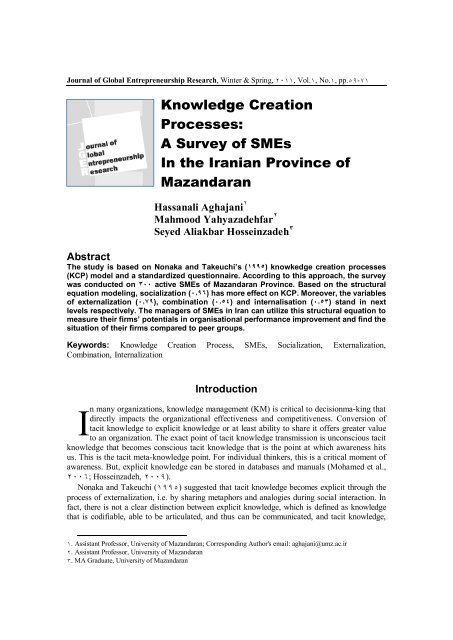
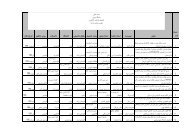
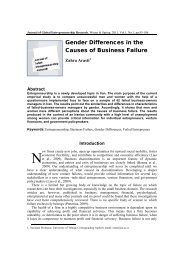
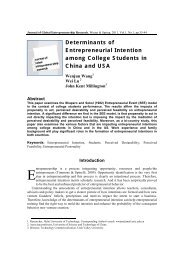
![÷Z e üË] Ã»à ¹â¬Â§ Ã{â¬Â§ cZ zÅ» : cÃà ve : žË¬» Ãů â¬Ãâ¹ ÃZ´Å¿Y ...](https://img.yumpu.com/48076597/1/184x260/aaz-e-aa-1-4-e-aaa-aaa-aaa-cz-zaa-caa-ve-a-3-4-eaa-aaa-aaa-azaaay-.jpg?quality=85)
